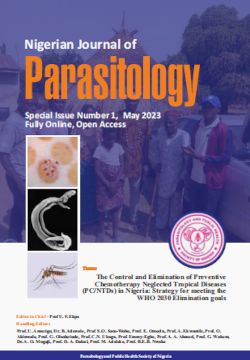Survey of Tick Infestations on Pet Dogs in Jalingo Local Government Area, Taraba State
https://dx.doi.org/10.4314/njpar.v42i2.6
Keywords:
Tick-borne disease, community health, Dermacentor, Ixodes, AmblyommaAbstract
The study investigated the prevalence of tick infestation among pet dogs in Jalingo Metropolis, Taraba State. The study area was fragmented into five study sites namely Kona, Magami Mayo-gwoi, Mile Six and Nukkai areas. Thirty samples were collected from each study sites using random sampling method. The prevalence of ticks infestation on dogs recorded was 80%. Prevalence was significantly different between the sites (χ2 = 13.333, p =0.0098). Amongst the tick genera observed, Ammblyomma had the highest prevalence, 44 (29.3%) followed closely by Ixodes spp., 41 (27.3%), and the least was Dermacentor, 33 (22.0%). Dogs of 108 (72.0%) of the respondent were vaccinated. Dogs of 82 (54.7%) of the respondents received treatment for diseases. Only 71 (47.3%) respondents used medicated soap, acaricide or chemicals to control dog ectoparasites. Attitudes of dog owners contributes directly or indirectly to tick infestation of dogs in Jalingo metropolis.
References
Sahu, A., Mohanty, B., Panda, M.R., Sardar, K.K. and Dehuri, M. 2013. Prevalence of tick’s infestation in dogs in and around Bhubaneswar. Veterinary World, 12: 982–985.
Norbert, M. 2013. Future challenges for parasitology: Vector control and 'One Health' in Europe. The veterinary medicinal view on CVBDS such as tick borreliosis, rickettsiosis and canine leishmaniasis. Special Issue: One World Health - Veterinary Parasitology in the Twenty First Century24th WAAVP Conferences. Veterinary Parasitology, 195(3-4): 256 – 271.
Okubanjo, O.O., Adeshina, O.A., Jatau, I.D. and Natala, A.J. (2013) Prevalence of Babesia canis and Hepatozoon canis in Zaria. Nigeria. Sokoto Journal of Veterinary Science, 11(2): 15 – 20.
Etim, S.E. 2012. Tick infestation and Babesia canis infections (In) formal of science. Engineering and technology 1(2), September 2012.
Nuchjangreed, C. and Somprasong, W. 2007. Ectoparasite species found on domestic dogs from Pattaya district, Chon Buriprovince, Thailand. Southeast Asian Journal Tropical Medical and Public Health, 38(1):203 – 207.
Uade, S.U., Liana, A., Jorg, H. and Anton, B. 2008. Parasites of importance for human health in Nigerian dogs: high prevalence and limited knowledge of pet owners. Veterinary Research, 49: 1746 – 6148.
Soulsby, E.J.L. 1982. Helminthes, Arthropods and Protozoa of Domesticated Animals, 7th ed., Bailliere Tindall, London. Pp 765 – 777.
Fleck, S.L. and Moody, A.H. 1988. Diagnostic Techniques in Medical Parasitology, 3rd ed. John Wright Butterworth Scientific University Press, Cambridge, 135pp.
Hoogstraal, H. 1956. Ticks of the Sudan U.S. Naval Medical Research Unit (3). Cairo, Egypt, pp1110.
Konto, M., Biu, A.A., Ahmed. M.I. and Charles, S. 2014. Prevalence and seasonal abundance of ticks on dogs and the role of Rhipicephalus sanguineus in transmitting Babesia species in Maidugiri, North-Eastern Nigeria. Veterinary World, 7: 119 – 124.
Diniz, P.P., Beall, M.J., Omark, K., Chandrashekar, R., Daniluk, D.A., Cyr, K.E., Koterski, J.F., Robbins, R.G., Lalo, P.G., Hegarty, B.C. and Breitschwerdt, E.B. 2010. High prevalence of tick-borne pathogens in dogs from an Indian reservation in northeastern Arizona. Vector Borne Zoonotic Diseases, 10(2):117–123.
Clark, R.P. and Hu, L.T. 2008. Prevention of Lyme disease (and other tick borne infections). Infectious Disease Clinics of North America, 22(2): 381 – 387.
Downloads
Published
How to Cite
Issue
Section
License
Copyright (c) 2023 Nigerian Journal of Parasitology

This work is licensed under a Creative Commons Attribution-NonCommercial-NoDerivatives 4.0 International License.




